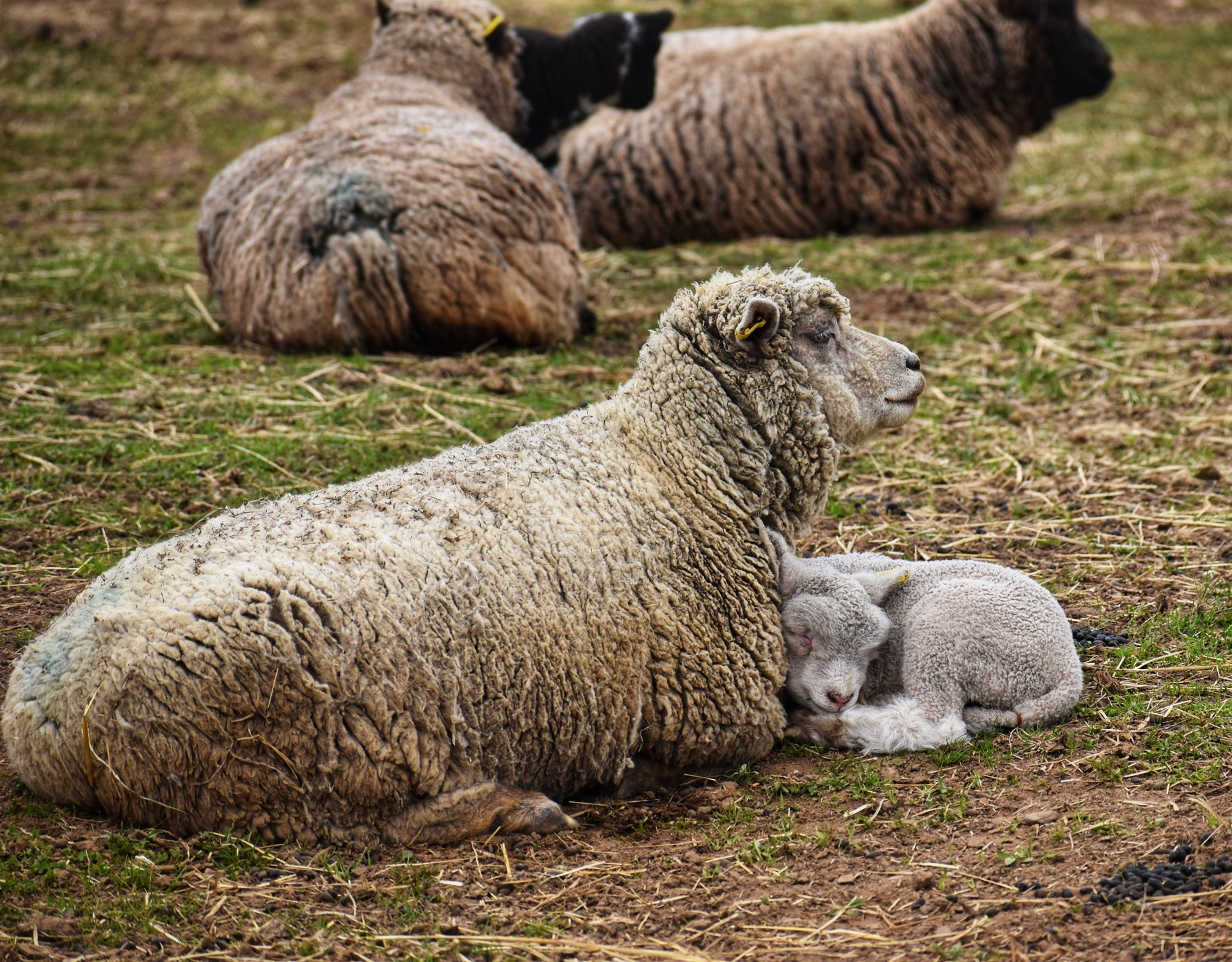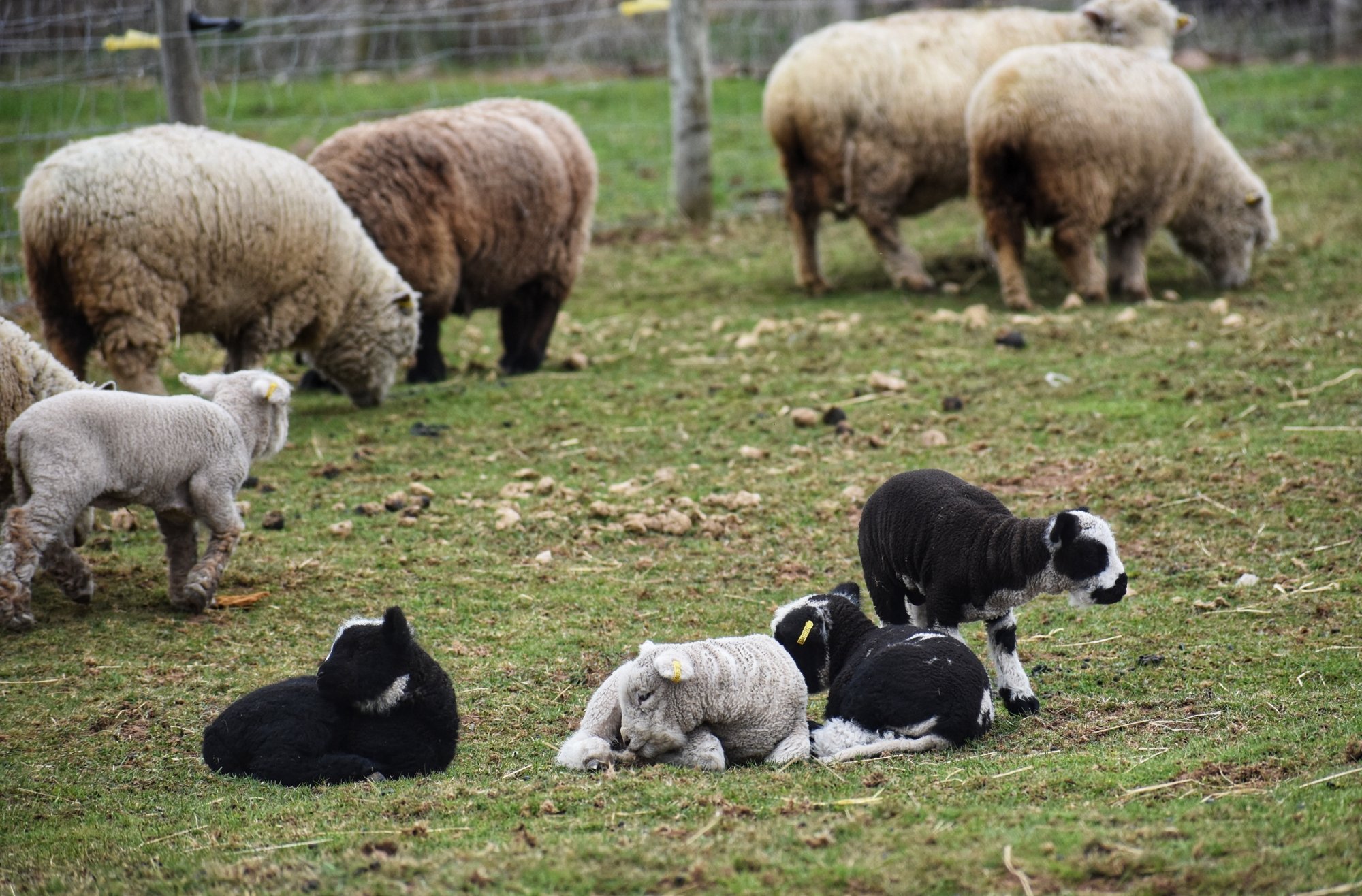words & photos by Colleen Thompson
Keeper of the flock
Rachel Lightfoot raises sheep and grapes in the Annapolis Valley.
A newborn lamb at Lightfoot & Wolfville
It's lambing season at the Lightfoot & Wolfville farm in the Annapolis Valley. A three-week period of little sleep and being on high alert for the keeper of the flock and modern-day shepherd Rachel Lightfoot.
It's a cold and drizzly Tuesday when I meet Rachel Lightfoot in the parking lot of the Lightfoot & Wolfville winery. Dressed in a stylish plaid raincoat and green Hunter boots, she greets me with her blithe vibe and a broad smile. You would never know that she had spent the previous three weeks running on little sleep, lifting animals more than her body weight, at times covered in amniotic fluid. It doesn't tell the story of the emotional rollercoaster. The three-hour rotation feeding schedule of twin lambs. Equal parts nerves of steel and tenderness.
She is through the busiest part of lambing season and has time to introduce me to the new cohort of thirty-three Olde English “Babydoll" Southdown lambs. All things considered, things have gone well this season. And like the nine previous ones, there have been triumphs and losses. But thirty-three new lives also feel like a gift after a difficult season in the vineyards, challenged by Hurricane Fiona and devasted by a polar Vortex in February. Lightfoot & Wolfville had just hosted the Tasting Climate Change conference the weekend before and are acutely aware of the climate change impact on farming and finding sustainable practices, which is an ongoing commitment. It's the whole reason for the sheep.
Lightfoot & Wolfville is a biodynamic farm, which means everything is done holistically and in synch with the land, the moon, and seasonal shifts. Before walking through the vineyards to meet the flock, I am handed plastic biosecurity booties to pull over my Blundstones. “The sheep are our natural mowers. They keep the weeds between the vineyard rows short, which impacts the health of the soil and eliminates the need for pesticides,” explains Lightfoot. “They start here, between the L’Acadie vines, and then we move them around to other vineyards. They fertilise as they go, and their hooves help build up the soil's microflora, making it more resilient.” Sheep in the vineyards are growing in popularity worldwide as wineries are realising the benefits and the research that points to enhanced carbon sequestration, improved soil health, and microbial biomass and nutrient content in vineyards. Healthier soil means better grapes, which ultimately means better wine.
We walk past a stall where Alder and Hartley, the two handsome rams, are kept—separate from moms and lambs—their job for the season is done. I see up close why the moniker "babydoll" sheep has been coined for the Olde English Southdown, a heritage breed that originated on the South Down hills of Sussex County, England, in the late 1700s. The sheep are smaller than most, stocky, with short legs, one white and the other brown with a black face. “We are attracted to heritage livestock breeds. Traditional breeds of a bygone era that were common before industrial agriculture became a mainstream practice bred out many original traits and forced these breeds to near extinction,” says Lightfoot. Olde English Southdown Sheep retain essential traits for survival and self-sufficiency, like a strong maternal instinct and natural resistance to diseases and parasites.
“We were initially attracted to the Olde English Southdown's smaller 'miniature' stature, which makes them particularly well suited for vineyard grazing. Then, we learned of their extreme hardiness, high-quality fleece, and the unmatched tenderness and flavour of their meat, so they are the perfect fit for our multifaceted farm and winery operation,” says Lightfoot.
The steel barn is a few meters away. The floor is covered in straw and open on one side so that lambs and ewes can wander in and out. A smell of hay, wet wool, and lanolin hangs in the air. Lightfoot has sectioned off a stall in the corner for Dani and her newborn lamb twins. The ewe has had a rough couple of weeks with lambing disease and is unable to feed her lambs. For a while, it was touch and go. “Things have eased up a bit. I had to bottle-feed these two every 3 hours, but now I'm down to about three feeds daily. At ten years old, Dani is one of our oldest ewes, and she developed a condition called pregnancy toxaemia. It's the first time I've dealt with this condition in over ten years of lambing,” says Lightfoot. “It's a metabolic disorder that can affect pregnant ewes during late gestation and is more common in ewes carrying multiple lambs. It is a condition characterised by a negative energy balance, where the ewe's energy requirements exceed its energy intake.”
The condition can be potentially life-threatening for the ewe and her unborn lambs. During late pregnancy, the energy demands of the growing lambs increase, especially during the last six to eight weeks before lambing. If the ewe doesn't consume enough energy to meet these increased requirements, her body uses fat reserves to compensate for the energy deficit. But, the excessive breakdown of body fat leads to the accumulation of ketones in the blood, resulting in pregnancy toxemia. As the condition progresses, ewes become unable to stand, appear depressed and eventually fall into a coma. It's just one of many challenges Lightfoot has handled this lambing season. And mishaps are part of every season. And in the words of poet and environmentalist Wendell Berry, “When you are new at sheep-raising, and your ewe has a lamb, your impulse is to stay there and help it nurse and see to it and all. After a while, you know the best thing you can do is walk out of the barn.”
Rachel Lightfoot with ewes and lambs
There was the ewe who rejected her lamb and would headbutt him whenever he came close. Two breech births required careful intervention to ensure the lambs were delivered safely. There were twins who both had their heads twisted behind their back legs. Sadly, the lambs were lost. But the triumphs and rewards are there too. Dani and her lambs are thriving. Something clicked, and the rejected lamb was finally accepted by his mama. He has filled out beautifully and has been selected by another local farm to become their future flock sire. And in a few weeks, the sun will shine, the buds on the vineyards will burst, and that feeling of exhaustion will turn to sheer joy.
Lightfoot's family has been working on this land for four generations. Rachel, one of five daughters, has chosen to follow in her grandmother's footsteps. "My great grandmother was farming organically and biodynamically long before we gave those things names,” says Lightfoot. “My father grew up here learning from my great grandmother who farmed in a way that would be considered natural farming today—composting, shunning chemical inputs, harvesting and planting according to the lunar cycle. To her it was just the commonsense way to care for your land and feed your family.”
Rooted in the philosophy of Rudolf Steiner, the biodynamic philosophy guiding Lightfoot & Wolfville looks at the farm as a whole, living organism. “At its core, biodynamic farming is a holistic vision of the farm as an integrated, whole, living ecosystem,” says Lightfoot. “This organism comprises several interdependent elements: fields, forests, plants, animals, soils, compost, people, and the spirit of place. Biodynamic farmers work to nurture and harmonise these elements, managing them in a holistic and dynamic way to support the health and vitality of the whole.” Animal husbandry is a crucial requirement in biodynamic farming and is central to providing precious manure important for increasing soil fertility. Diversity in animals is also beneficial, with each animal bringing a different relationship to the land and unique quality of manure.
Over the last few years, Lightfoot & Wolfville have added several heritage breed livestock (Olde English Southdown Sheep, Jersey x Wagyu cross Cattle, Berkshire cross, and Mangalitsa Pigs), each playing an essential role within the whole-farm system. “The sheep act as lawnmowers and live within the vineyard at certain times of the year,” Lightfoot explains, “grazing the weeds and cover crops and providing organic fertilizer, and the pigs happily forage on our leftover grape skins and vegetable garden scraps. They clear the thick brush through their innate rooting behaviour, promoting airflow and helping with mildew prevention... Here, on the land unsuitable for viticulture, we produce forage for the livestock, such as hay and silage, which they eat throughout the winter months when they no longer grazing on pasture.”
We leave the barn and head outside into the enclosed lambing paddock, like a lamb playschool. It's hard not to go weak in the knees at the sight of thirty lambs frolicking, and the energy and pure joy is palpable. We stand quietly amongst the ba-a-ing, prouncing, frolicking, climbing, suckling, and napping. Lightfoot knows the names of all the ewes and all the stories that accompany them: Lily, Juniper, Indigo, Hazel, Gemini, Daisy, Daffodil, Junebug, Clover, Iris, Chamomile, Julep, Lavender, and Lilac. “You must have a gentle presence,” Lightfoot assures me as I walk among them, taking photographs, “the lambs are usually very skittish, but they are so calm.” They do bring a sense of calm, and I could happily hang out with them all day.
“I've learned some simple and vital truths through my sheep,” says Lightfoot. “Through their annual cycles of lambing, weaning, shearing, pasture rotations, and vineyard grazing, they help keep me connected to the seasonal rhythms and vibrant nature of the farm while teaching me resilience, discipline, and hope.” 🐑


Lightfoot & Wolfville Vineyards
11143 Evangeline Trail, Wolfville, NS
lightfootandwolfville.com
Colleen Thompson is an award winning writer and photographer based in Halifax, N.S., who favours writing about food and storytelling that accompanies it. Follow her journey @monkeyweddings
This piece appeared in Fall 2023, Edible Maritimes #9

